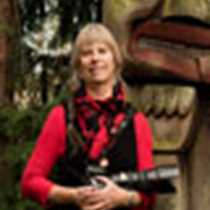Saook Bay, Lake Eva on Baranof Island, Sitkoh Bay on Chichagof Island
Just after sunrise this morning the National Geographic Sea Lion made her way into Saook Bay on Baranof Island. This tiny inlet has a salmon river at its far end and spectacular scenery along its entire passage. As the bridge officers made a slow passage, the morning light brightened the extraordinary reflections along the sides of the bay. Many sea birds were earnestly trying to make a living in the nutrient-rich waters of Southeast Alaska, tipping and retrieving small fish, flying off to feast! In flat calm conditions the National Geographic Sea Lion continued her slow cruise to the end of the bay searching for wildlife along the shore, and slowly we awoke to our first day in Southeast Alaska...mists in the forest, bird song on the light breeze, reflections along the shoreline all mixed into a world dominated by the colors of gray, blue and many shades of green in the mountains on both sides of Saook Bay.
The National Geographic Sea Lion moved back into Peril Strait and, heading slowly southeast, made her way into another inlet at the southern end of Chichagof Island called Sitkoh Bay. This particular bay holds the threads of the fabric of much human history. The Kikasdi Tlingit from Sitka fled across Baranof Island in 1804, establishing a new village at the entrance of Sitkoh Bay at Pt. Craven, where they remained for more than twenty years after battling the Russians in Sitka. They built signal fires to attract the attention of the Tlingit of Angoon across Chatham Strait; in hopes of aid and renewed closer association as the Kikaski planned to remain in Sitkoh Bay indefinitely...a protest to the Russian presence in Sitka and a way to remain independent of the invasion of non-native settlers to the home country of Kikasdi of Sitka and Southeast Alaska.
The National Geographic Sea Lion continued her cruise into the heart of Sitkoh Bay past the old sockeye cannery, which has been deserted for some years. The bay became the site of a commercial salmon fishery beginning in the late 1800s, and a salmon cannery beginning in 1900. The cannery era coincided with a period of rapid socioeconomic and sociocultural change for the Tlingit throughout Southeast Alaska; changes there were to a large degree precipitated by the commercialization of the salmon fisheries. Overfishing gradually affected much of Southeast Alaska, especially Sitkoh Bay, which eventually was closed to all commercial fishing.
In the late morning our first presentation of the voyage began in the forward lounge; an introduction to photography by our photo specialist. The light in Southeast Alaska is renowned...mixed with those things large and small; we learned new and different ways to bring this to life in our photos. The late-morning talk finished just before lunch and a nourishing respite before our afternoon ashore on Baranof Island. The ship anchored in Hanus Bay, a small cove on the northeastern coast of Baranof Island. Our goal was to enjoy a variety of levels of hikes all making their way somewhere near Lake Eva which provided the headwaters of Eva Creek and a well-known salmon river and lake for several species of Pacific salmon.
Hikers and kayakers both had an opportunity to explore the many inlets attached to Hanus Bay...from cascades at the base of Eva Creek, to the old-growth forest that runs along both Eva Creek and its headwaters, Lake Eva. The refurbished trail provided a wonderful compact trail meandering through the forest, muskegy environ, glacial erratics and many, many varying old trees; both Sitka spruce and western hemlocks! It is early fall in Southeast Alaska and the vegetation is signaling fall decay, fecundity and all the smells that go along with that stage of growth and death were present all around us! Mushrooms were exploding their fruiting bodies on dead organic material everywhere. Coral mushrooms, amanitas, chicken of the forest all were providing color to the floor of the forest and trunks of many trees! Even a scrambled egg slime mold was creeping across the floor of the forest; all signs of the rapidly waning summer light leading all living organisms towards fall and winter in the north.
Today though, we were blessed with sunshine in the woods! Filtered light illuminated the forest providing wonderful photography for everyone hiking in the shadows of giant trees. Kayakers also enjoyed warm airs and clear light allowing the capture of life at the forest edge in particular, a scene of watching an eagle snatch a salmon from the sea, move a short distance and begin an afternoon meal...this time of year is a time of the harvest of the salmon; for bears, birds, and all the human settlements. Following the salmon home has been part of the Northwest Coast tradition for thousands of years and today, our first day of exploration, we watched salmon jump in the sea, had a chance to sit on the bank of a river and glimpse salmon heading towards spawning grounds, resting in shallow water under a downed tree, making our first observations of this interwoven and complex web of life that so strongly represents the nutrient-rich waters, land and the magic that is the Northwest Coast.




